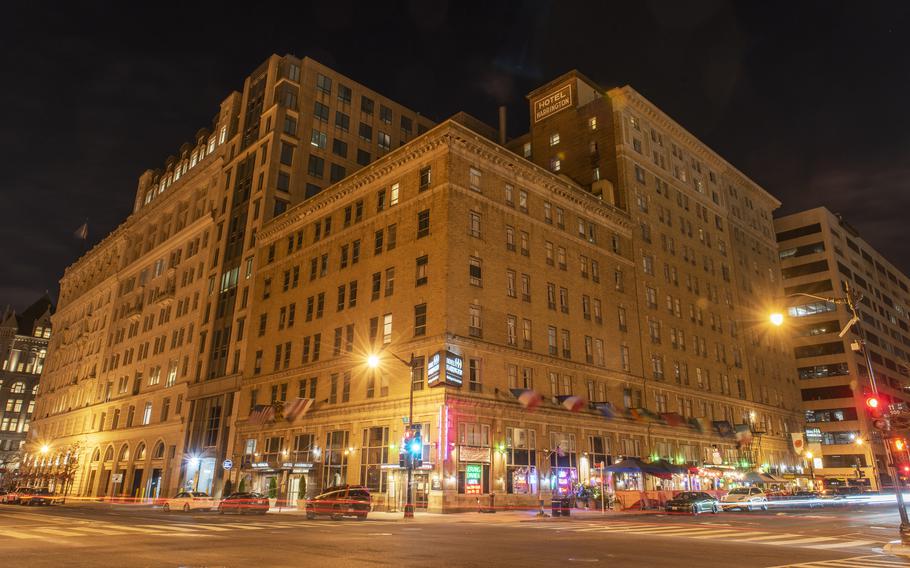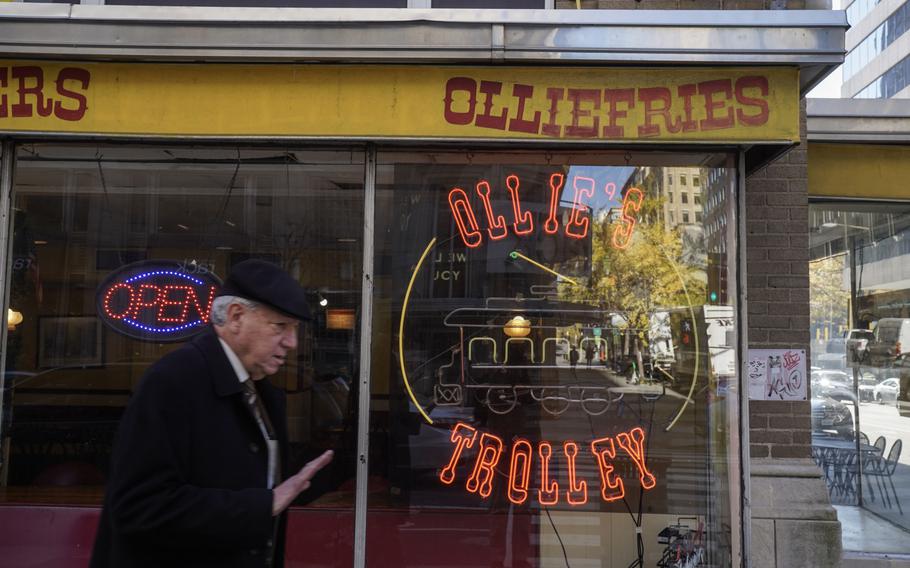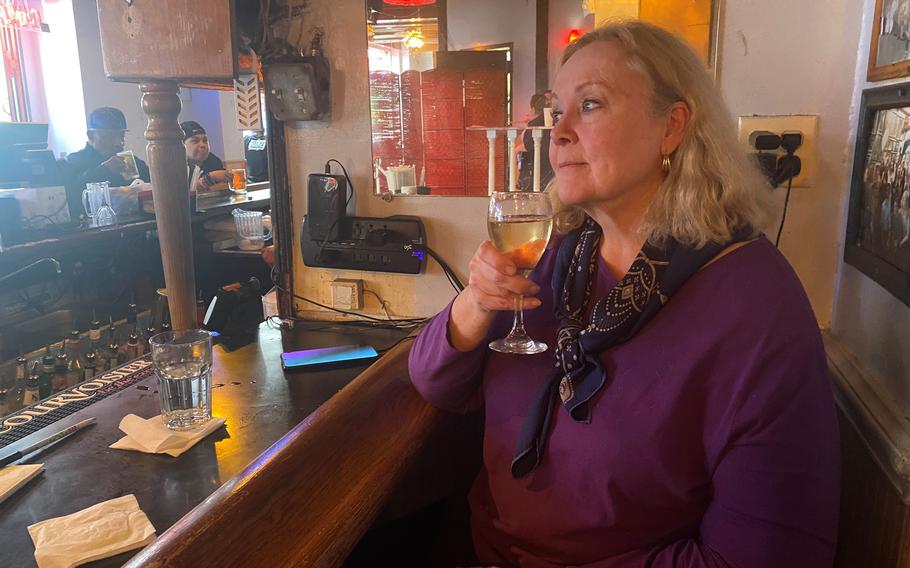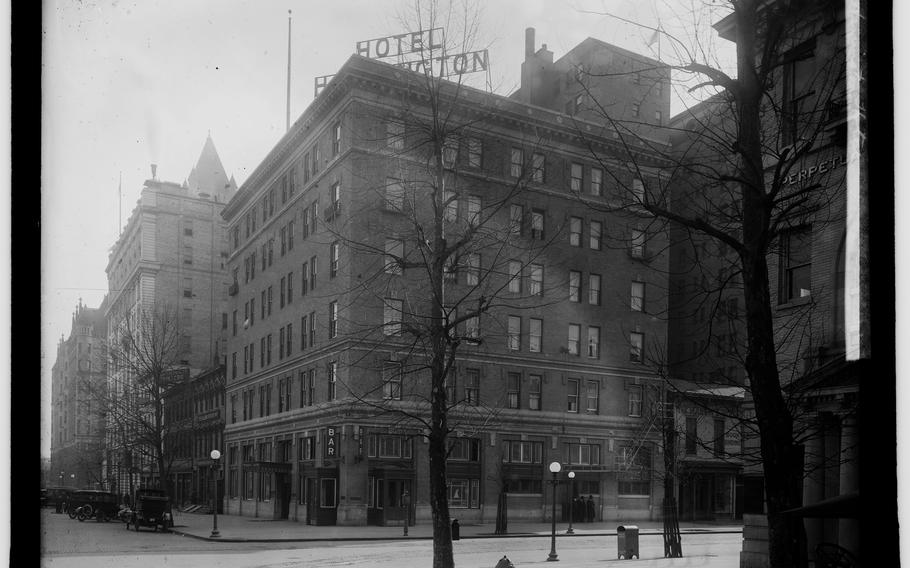
The Harrington in downtown Washington has closed after 109 years, ending its reign as the city’s longest continuously operating hotel. (Craig Hudson/For The Washington Post)
The air conditioning system is out of date, the bathrooms are cramped and the occasional creepy-crawly has been known to drop by unannounced.
No one has stayed at the Hotel Harrington in downtown Washington because it is luxurious, elegant, or, for that matter, especially nice.
Mostly it’s the Harrington’s bargain rates and stellar location — a few blocks from the White House and National Mall — that has drawn tourists from across the United States and Europe for more than a century.
“We go up to our room and my brother touches the closet door and it falls off,” Linda Levine of Raleigh, N.C., said the other day, recalling a stay at the Harrington in the late 1990s. “There was a stain of unknown origin in the bathroom.”
Still, Levine added, “It was an affordable way to see the city.”
The Harrington’s recent announcement that it’s closing Dec. 12 after 109 years will end its reign as the city’s longest continuously operating hotel, an accomplishment inspiring testimonials, as well as wonder that something so profoundly meh could last so long.
The Harrington also has the distinction of belonging to a subset of Washington hotels that have achieved infamy, a group that includes the Vista, where the FBI videotaped then-Mayor Marion Barry smoking crack, and the Mayflower, where Eliot Spitzer’s rendezvous with a prostitute led to his resignation as New York’s governor.
In the case of the Harrington, at 11th and E streets NW, hundreds of Proud Boys turned it into a de facto clubhouse for election-denying Donald Trump supporters in 2020 and camped out at Harry’s, the hotel’s in-house dive bar.
With the Harrington closing, Harry’s stopped serving Dec. 3 after 30 years, while another tenant, Ollie’s Trolley, a burger joint that, by all appearances, hasn’t freshened up since opening in 1989, is also shutting down.

A pedestrian walks past one of the neon signs at Ollie’s Trolley on Nov. 16. The landmark Washington burger joint will soon be shutting down. (Michael Robinson Chávez/The Washington Post)
For the uninitiated, mourning the passing of the Harrington may seem as inconceivable as, say, tearing up over the closing of a Motel 6. But to its devotees — the generations of tourists, Boy Scout troops and school groups that came from all over, the regulars who drank Harry’s cheap beers and inhaled Ollieburgers — the Harrington is an unbuttoned oasis in an otherwise buttoned-up downtown.
“It’s like a scene out of a Toulouse-Lautrec painting,” Kimberly Ashworth, 71, said, referring to the French painter who immortalized 19th-century Parisian nightlife, as she sipped white wine at Harry’s before it closed and rhapsodized about its legacy. “I’ve never seen a place where the highbrow, lowbrow and no brow come. Law enforcement, attorneys, lobbyists, government people, hookers, drug dealers — it’s always something.”
Ashworth, a retired U.S. Customs policy analyst who described her political affiliation as liberal, said the presence of the Proud Boys at Harry’s during those calamitous days of the Trump administration made the place “more interesting.”
“I was actually kind of tickled that my hole-in-the-wall bar was in the news,” she said. “It was kind of entertaining. It brought in cash for Harry’s during COVID. Who was it that said there’s no such thing as bad publicity?”

Kimberly Ashworth, a retired federal policy analyst, enjoys a white wine at Harry’s on Nov. 17. The Harrington’s in-house dive bar stopped serving Dec. 3 after 30 years. (Paul Schwartzman/The Washington Post)
Ann Terry, the Harrington’s managing director, initially agreed through a public relations representative to be interviewed about the hotel’s history and decision to shut down. The representative then canceled the interview. Instead, the hotel released a statement that “it will close pending its sale.” The statement did not provide additional detail about the timing or reasons for shutting down.
“The Harrington has seen our nation experience many events — 19 different Presidents, two World Wars, the Great Depression, the civil rights and women’s movement and many more,” the statement said. It made no reference to its Trump-era cameo.
John Boyle, Harry’s owner, said the Harrington’s demise seemed inevitable after the 2020 death of the hotel’s owner, Charles McCutchen, a physicist whose grandfather was one of its two founders.
“We had 26 really good years — the last three or four haven’t been pleasant,” Boyle said in a phone interview. “It’s time to go. I’m ready.”
The pandemic was brutal for the hotel’s tenants, emptying downtown of tourists and white- and blue-collar workers, many of whom, over the course of decades, came for lunch, nightcaps and everything in between.
“I’m living off scraps,” said Boris Galitzen, whose family owns Ollie’s and who hopes to reopen somewhere else, though without the restaurant’s unmistakable yellow sign and a porcelain cow that hangs from its ceiling, both of which are being auctioned off. “I’m devastated.”
The Harrington was conceived by Harrington Mills and Charles McCutchen, two businessmen who opened the hotel’s original six story building in 1914, when Woodrow Wilson occupied the White House and the country was on the cusp of World War I.

The Harrington Hotel, as it looked in about 1916, two years after it opened in 1914. (Library of Congress)
Over time, the Harrington would build two 12-story additions and become, by its own account, the city’s first hotel to install air conditioning. A television station — then known as W3XWT and now WTTG-Channel 5 — opened a studio at the hotel in the 1940s, where it later broadcast the Milt Grant Show, a local version of American Bandstand.
But the Harrington was known mainly as “Washington’s Tourist Hotel,” as the sign on the building still proclaims, an affordable alternative to the costly comforts at Beaux-Arts palaces like the Willard and Raleigh Hotel. (A room with a king-size bed at the Harrington goes for $185 these days, compared with $324 at the Willard.)
The Harrington was a product of “the Henry Ford era when the idea of efficiency and economy permeated everything,” said John DeFerrari, a Washington Preservation League board member who is writing a history of the city’s hotels. “For hotels, that translated into standard rooms where everything was regimented as opposed to the grand old hotels, which gave everyone their own special treatment.”
Charles Phoenix, a pop culture humorist who riffs about Americana, described the Harrington as a time capsule of social history and architectural styles. As he arrived at the hotel on a recent visit, Phoenix said he was struck by what he described as the “layers of time” — original art deco trimmings on the building’s exterior, with a front desk “trying to be old timey but clearly with a 1970’s wood finish.”
“The charm of it for me was how completely unpretentious it was — it’s living in a world where form follows function,” Phoenix said. “I saw such a wide variety of people. There were Hasidic Jews staying there. There were Amish people. I spoke to people from France and Germany. It was a melting pot.”
With the hotel’s closing, he said, “We lose the stories, we lose the lore. It fades away.”
Still, for many visitors, past and more recent, the memories remain vivid, for better or worse.
Victoria Frederick, a retired Washington public schools administrator, worked in an office next door to the Harrington until the late 1980s. She and co-workers regularly went to lunch at the hotel’s cafeteria-style restaurant, then known as the Kitchiteria. Sometimes she’d have a drink at the Pink Elephant Cocktail Lounge, the bar that preceded Harry’s.
“The Harrington was not the kind of place you’d tell a relative from out of town, ‘Hey, honey, stay there,’” Frederick said. But, she added, meals were another matter. “You could get liver and onions and a good breakfast with actual biscuits.”
The hotel is always fodder for lively internet guest reviews, many of which are quick to extol its convenience while warning that no one should expect the Ritz.
“It felt like staying at grandma’s house,” someone wrote on Tripadvisor in September. “Great location, but a dive.”
Eileen Silverman’s main memory from her 1971 visit to the Harrington with her “future fiancé” was the “huge roach” that made itself visible when she was “turning down the bed.”
“We were from New York and had never seen one that big,” she wrote in a text. “Assumed it was a ‘southern’ thing.”
Silverman also shared her experience in the comment section of a Facebook post about the hotel’s closing, where others wrote of long ago sightseeing trips to Washington and one lamented that “the DC of my childhood is slowly slipping away!”
Tom Baron, a Harry’s bartender from 1995 until 2010, said it was the disarming lack of ostentation that kept all varieties of humanity coming back. On any given night at Harry’s, he said, his patrons might include FBI agents, off-duty strippers and Harrison Ford, who stopped in when he was in town shooting a film.
“He said, ‘Call me Harry’ and I’m like, ‘Harry? Are you kidding me?’” Baron recalled. “I asked him if he wanted a shot and he said, ‘Only if you do one with me.’”
Baron was no longer working at Harry’s when the Proud Boys made their appearance, but he was saddened and angered that the events of 2020 damaged the reputation of a place where he worked for 15 years and met his wife.
“It was all about inclusion,” he said of the bar. “And it was tarnished for something it wasn’t.”
Boyle declined to talk about the Proud Boys, saying, “I’d rather forget the whole thing.” But he also said that over three decades Harry’s served a diverse clientele, whether it was members of the Clinton, Bush or Obama administrations or those who came to Washington for demonstrations, including the Million Man March in 1995 and the recent rallies in support of Israel and Palestine.
At closing time, he said, bartenders at the nearby Trump hotel, when it was still in business, sent Trump administration officials and their crowd to Harry’s where they could order far less expensive drinks.
“We don’t say, ‘You can come in and you can’t,’” Boyle said. “We’re a place where people feel comfortable going.”
On a recent afternoon, a bartender at Harry’s told lunchtime patrons that after the bar shuts down in December they can go to Joey’s, a new place Boyle is helping to open on Capitol Hill. Asked about Joey’s, Boyle said it would be a “neighborhood family restaurant.”
“It’s not going to be a MAGA bar,” Boyle said. “It’s not a dive spot. It will have brand-new furniture and be sharp and clean. It’s not going to be Harry’s. I don’t really like dive bars.”
“Let’s start with a clean slate,” he said, adding that he hopes not to be around. After decades in the bar business, he said he plans to spend most of his time in Florida playing pickleball and golf.